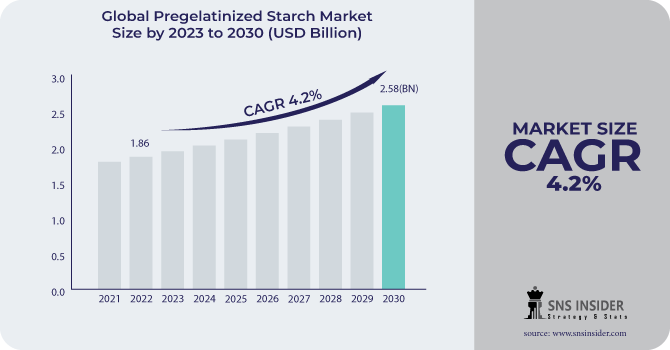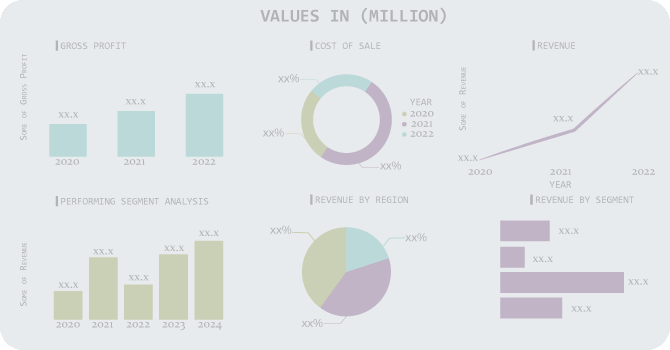Pregelatinized Starch Market Report Scope & Overview:
The Pregelatinized Starch Market size was USD 1.86 billion in 2022 and is expected to Reach USD 2.58 billion by 2030 and grow at a CAGR of 4.2 % over the forecast period of 2023-2030.
Pregelatinized Starch is a customized starch that has undergone physical or chemical modification to cause it to expand when exposed to cold water. In a variety of industries, including food, medicines, and paper, it is primarily employed as a thickening agent and stabilizer.

Based on type the market is segmented into Wheat Flour, Potato Starch, Corn Starch, and others. Corn is a staple meal that is popular around the world due to its role in many countries' diets. The feedstock has a large impact on corn starch prices. Corn, often known as maize, accounts for nearly three-fourths of total global starch output. Corn starch is a key source of starch used in the food industry as a thickening agent or binder. It is often used in soups and liquid-based meals including gravies, custards, and sauces.
Due to the rising demand for processed foods, the food and beverage industry has the biggest market share by application. The premiumization, functionality, convenience, and sustainability developing trends are driving constant change in the global food and beverage industry. As it improves liquid medium consistency at room temperature, it is widely employed in the food business. It is therefore appropriate for instant food items including sauces, dry mixes, sweets, baby food, soups, and cake powders. There is a demand for the product since people are buying more processed and ready-to-eat meals. This starch is being more widely used across a variety of industries as a result of the development of cutting-edge technologies and creative experimentation in the food and beverage industry.
MARKET DYNAMICS
KEY DRIVERS
-
Growing demand for Ready-to-eat and processed food
Pregelatinized starches, whether native or modified, are extremely helpful granular dietary starches that disintegrate quickly in cold water. They've been dried and baked ahead of time before being ground into flake or powder form. The starches break down fast and completely, allowing them to reach their maximum viscosity without cooking. This makes consumer foods more convenient. As the world's population grows, so does the need for processed and convenience foods. It is a main ingredient found in ready-to-eat food products. The growing need for processed foods is increasing demand for modified starch, which is expected to drive market growth. It also provides valuable features in processed meals like as appearance, flavor, and consistency, which serve to extend the shelf life of food goods.
RESTRAIN
-
The breakdown of starch molecules requires a large amount of energy.
Pre-gelatinization is a time-consuming process that requires heating starch with water or steam. As a result, pregelatinized starch may be more expensive as an ingredient than native starch. The high energy requirement of the pregelatinization process might also cause environmental problems. Greenhouse gases are discharged into the atmosphere when starch is cooked. This could accelerate climate change.
OPPORTUNITY
-
Rising product demand in various application
The market is expanding rapidly as the product improves the sensory and textural features of samples, and crosslinked starch impacts the baking properties of the product in a variety of applications including food and beverage, pharmaceuticals, cosmetics, personal care, textile, and others. It is one of the components used in tablet manufacturing. These starches serve as a binding agent or a diluting agent during the tablet production process. The growing older population and increased need for medications are driving market growth.
CHALLENGES
-
Fluctuating prices of raw materials
Typically, pregelatinized starch is manufactured from corn, wheat, or tapioca starch. The pricing of these basic resources might vary depending on a variety of circumstances, including weather and crop output. This can make it difficult for pregelatinized starch makers to keep their prices consistent.
IMPACT OF RUSSIA-UKRAINE WAR
Russia Ukraine war has had an influence on the market for pregelatinized starch. Russia and Ukraine are key producers of these products, and the war has reduced their exports significantly. This has resulted in higher raw material prices, which has increased the cost of making pregelatinized starch. The war has hampered the availability of raw materials for pregelatinized starch, such as corn and wheat. Corn, a vital raw ingredient for pregelatinized starch, has increased by more than 50% since the war began. The battle is anticipated to reduce the worldwide pregelatinized starch market by 10% in 2023. There is also a reduction in sales of processed and convenience foods.
IMPACT OF ONGOING RECESSION
The recession has impacted the market for the pregelatinized starch market. The price of wheat, another key raw material for pregelatinized starch, has increased by over 30% since the start of the war. Similarly, corn and potato prices are high due to factors like climate conditions, high shipping charges, and inflation. This can lead to a decline in the demand for pregelatinized starch, which is used in a variety of products, including processed foods, instant foods, and pharmaceutical products.
MARKET SEGMENTATION
By Type
-
Wheat Flour
-
Potato Starch
-
Corn Starch
-
Others
By Application
-
Cosmetic
-
Pharmaceutical
-
Food and Beverage
-
Others
.png)
REGIONAL ANALYSIS
Europe region is growing significantly where the market held revenue of USD 1 billion in 2022 due to the presence of the cosmetic industry and food & beverage sector. This increase is due to increased demand for personal care and cosmetic items. Increased use of starch in this industry is expected to drive market expansion.
North America currently maintains the second-largest market share for pregelatinized starch with a growth of 3.4% due to increased product demand in the food and beverage industry. The presence of important firms in the area is anticipated to boost output and improve starch supply to diverse industries. Important players in the food and beverage sector include Kraft Heinz, Nestle, and others.
Asia Pacific is predicted to grow at a CAGR of 4.9 % and will tend to show a considerable growth rate during the forecast period, as a result of the expansion of the pharmaceutical industry and the expansion of the industrial infrastructure. Additionally, several factors, including the surge in demand for cosmetics and the popularity of packaged foods, are creating several potential for the market to expand.
REGIONAL COVERAGE
North America
-
US
-
Canada
-
Mexico
Europe
-
Eastern Europe
-
Poland
-
Romania
-
Hungary
-
Turkey
-
Rest of Eastern Europe
-
-
Western Europe
-
Germany
-
France
-
UK
-
Italy
-
Spain
-
Netherlands
-
Switzerland
-
Austria
-
Rest of Western Europe
-
Asia Pacific
-
China
-
India
-
Japan
-
South Korea
-
Vietnam
-
Singapore
-
Australia
-
Rest of Asia Pacific
Middle East & Africa
-
Middle East
-
UAE
-
Egypt
-
Saudi Arabia
-
Qatar
-
Rest of Middle East
-
-
Africa
-
Nigeria
-
South Africa
-
Rest of Africa
-
Latin America
-
Brazil
-
Argentina
-
Colombia
-
Rest of Latin America
KEY PLAYERS
Some of the key players are Cargill Incorporated, Galam, Grain Processing Corporation, Tate & Lyle, Visco Starch, S A Pharmachem Pvt Ltd, Crest Cellulose, Banpong Tapioca Flour Industrial Co Ltd, Karandikars Cashell Private Ltd, DFE Pharma, and other key players.
Cargill Incorporated-Company Financial Analysis

RECENT DEVELOPMENTS
In 2022, Lory Starch Opal, a spray-on adhesive for seeds and various decorative culinary seasonings, was introduced by Loryma. The spray is constructed of pregelatinized wheat starch, with a focus on solubility to facilitate spraying. The substance can be sprayed onto baked goods for boutique producers or utilized in large quantities for industrial production.
In 2022, DFE Pharma of Goch, Germany, introduced the Nutroféli series of starch-based excipients for nutraceuticals. Excipients are derived from nature and serve multiple functions as binders, fillers, and disintegrants in oral solid dosage forms. Nutroféli ST100 is a native starch excipient, Nutroféli ST200 is a slightly pregelatinized starch, and Nutroféli ST300 is a fully gelatinized starch300.
In 2021 American Key Food Products announced that it is now providing the North American food market with Native Waxy Potato Starch and Pregelatinized Native Waxy Potato Starch manufactured in Germany.
| Report Attributes | Details |
| Market Size in 2022 | US$ 1.86 Billion |
| Market Size by 2030 | US$ 2.58 Billion |
| CAGR | CAGR of 4.2 % From 2023 to 2030 |
| Base Year | 2022 |
| Forecast Period | 2023-2030 |
| Historical Data | 2019-2021 |
| Report Scope & Coverage | Market Size, Segments Analysis, Competitive Landscape, Regional Analysis, DROC & SWOT Analysis, Forecast Outlook |
| Key Segments | • By Type (Wheat Flour, Potato Starch, Corn Starch, Others) • By Application (Cosmetic, Pharmaceutical, Food and Beverage, Others) |
| Regional Analysis/Coverage | North America (US, Canada, Mexico), Europe (Eastern Europe [Poland, Romania, Hungary, Turkey, Rest of Eastern Europe] Western Europe] Germany, France, UK, Italy, Spain, Netherlands, Switzerland, Austria, Rest of Western Europe]), Asia Pacific (China, India, Japan, South Korea, Vietnam, Singapore, Australia, Rest of Asia Pacific), Middle East & Africa (Middle East [UAE, Egypt, Saudi Arabia, Qatar, Rest of Middle East], Africa [Nigeria, South Africa, Rest of Africa], Latin America (Brazil, Argentina, Colombia Rest of Latin America) |
| Company Profiles | Cargill Incorporated, Galam, Grain Processing Corporation, Tate & Lyle, Visco Starch, S A Pharmachem Pvt Ltd, Crest Cellulose, Banpong Tapioca Flour Industrial Co Ltd, Karandikars Cashell Private Ltd, DFE Pharma |
| Key Drivers | • Growing demand for Ready-to-eat and processed food |
| Market Restrain | • The breakdown of starch molecules requires a large amount of energy. |

